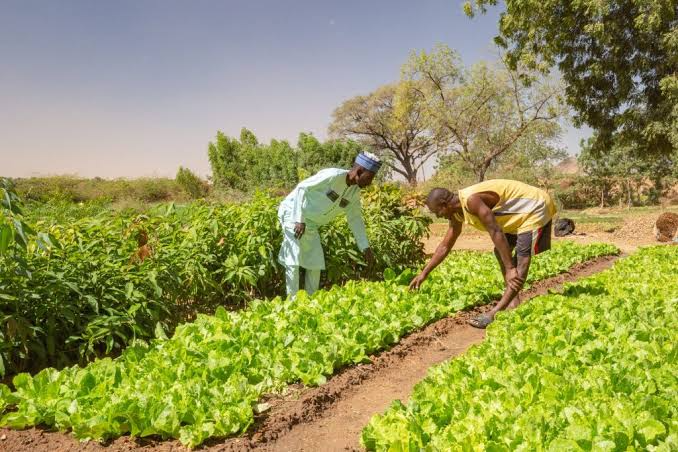By Oladeinde Olawoyin, Ronald Adamolekun, Abdulkareem Mojeed, Ntiedo Ekott
——————————
This is the second part of our series on post-harvest losses. Read the first part here.
Rice
Nigeria loses 20 to 40 per cent of its rice at harvest points and market stages. Beyond food wastage, postharvest losses along the rice value chain also come with implications for climate change, accounting for emissions of around 0.65 million tonnes of CO2 eq, into the atmosphere.
For Victoria Nwachukwu, a 53-year-old farmer based in Onicha Local Government Area in Ebonyi, one of Nigeria’s biggest rice-producing states, poor roads and lack of market access are the top factors behind postharvest losses in rice in her community.
“Many people may come to the state looking for rice, but they cannot enter communities like ours because of bad roads,” she told PREMIUM TIMES.
“If you consider the money you will pay to move these goods out to the market, it may exceed the profits you are to make from the sales. So, bad road infrastructure and access to the market are major challenges in this business for us in this community.”
Amegu Amanator, where Ms Nwachukwu cultivates the grain, is usually a 45-minute drive from Abakaliki, the state capital. However, because of the poor condition of the roads, travel time is roughly two hours.
Early this year, she lost 18 units of 100kg bags of rice worth N1.7 million due to transportation constraints while attempting to convey the produce from the farm to the market. Due to her experience, Mrs Nwachukwu is scaling back her cultivation.
Nigerians need credible journalism. Help us report it.
PREMIUM TIMES delivers fact-based journalism for Nigerians, by Nigerians — and our community of supporters, the readers who donate, make our work possible. Help us bring you and millions of others in-depth, meticulously researched news and information.
It’s essential to acknowledge that news production incurs expenses, and we take pride in never placing our stories behind a prohibitive paywall.
Will you support our newsroom with a modest donation to help maintain our commitment to free, accessible news?
“We don’t have storage facilities here, but it’s not a problem for me because I normally dry and also use chemicals to preserve my rice after harvesting,” said Victoria Chinyere, who has a farm in Oshiri in the same local government.
 INFOGRAPH: Postharvest Losses: Postharvest losses in rice production in Nigeria have been observed to fall between 20 -40 %.
INFOGRAPH: Postharvest Losses: Postharvest losses in rice production in Nigeria have been observed to fall between 20 -40 %.“The demand for rice is high, so I don’t experience many losses. Immediately I finish harvesting, buyers will come and pick them all because our place is accessible.”
Extending grains’ shelf life by applying chemicals raises health concerns. Lots of grains stored in silos are preserved with heavy, toxic chemicals, which sometimes make them unfit for consumption. Though consumed locally, such grains fall short of international safety standards and are rejected at the point of export after the discovery of chemical residue on them.
Owing to the unavailability of storage facilities, which cost him N1.3 million two years ago, smallholder John Nnabo, who plants rice in Oshiri, Onicha Local Government Area of Ebonyi State, now uses private-owned storage facilities. He pays between N1000 and N2000 monthly for every 100 kg of rice. That will help preserve the produce, pending when he starts milling the grains, while he preserves the rest with chemicals at home.
“The sit-at-home order is a major cause of postharvest loss in the community. We cannot take rice to the market on Mondays. Because of this, the colour of the harvested rice normally changes, which will reduce the quality and value,” he told PREMIUM TIMES, referring to the controversial sit-at-home imposed on states in south-east Nigeria by the secessionist group IPOB.
The World Resource Institute observed that: “any innovations in managing postharvest losses, such as the use of hermetic bags for grain storage, cold room facilities for perishable foods, etc., have meagre adoption rates in Africa. To help shift these low adoption rates, it’s important to co-design such innovations with local farmers and entrepreneurs at the centre while investing in local small- and medium-sized enterprises to help scale businesses. These enterprises also need government support, including public investments, tax incentives and policies to scale.”
Yam
According to the Food and Agriculture Organisation (FAO), Nigeria accounts for 69.2 per cent of the world’s yam production, with 61.2 million tonnes of the crop produced in 2022.
Yam Improvement for Processing (YIP) Nigeria, a study of the yam value chain in the country executed by Sahel Partners & Advisory between December 2013 and 2014, found postharvest losses in the crop range between 20-30 per cent, depending on the yam variety.
“We don’t have storage equipment. We only preserve our yams based on how we make our storage space conducive for our yams, something like thatched houses where ventilation is much,” Japheth Ishenge, secretary of the Association of Yam Shade Owners and Yam Sellers Zaki Biam Market, told PREMIUM TIMES.
Located in the Ukum Local Government Area of Benue State, Zaki Biam Market is regarded as the world’s largest yam market.
“If it’s in a thatched house, we understand that the ceiling is there (to protect the yams),” he said. “If it’s in a zinc house, we understand that the ceiling is there, so we spread sand on the floor before we lay the yams on it instead of putting them directly on concrete.”
 INFOGRAPH: Postharvest Losses: 61.2m tonnes of yam was produced by Nigeria in the year 2022.
INFOGRAPH: Postharvest Losses: 61.2m tonnes of yam was produced by Nigeria in the year 2022.Mr Ishenge noted that farmers and traders in the state record about 40 per cent of post-harvest wastage in yam. He added that the exposure of the tubers to heat and moisture due to the absence of safe storage houses is among the principal factors stoking decay. He stated that excessive application of fertiliser also causes yam spoilage.
Some farmers sprinkle chemicals on yams to reduce spoilage and, ultimately, wastage, he said. However, many farmers do not adopt this preservation method because of the adverse health implications for consumers.
Traders from Cameroon, Niger and Ghana regularly come to Zaki Biam Market to purchase the yam tubers.
The market accounts for about 70 per cent of the yam cultivated in Nigeria, with more than 200 trucks loading two million tubers of yam every week, not to mention buses and smaller vehicles.
Until 2020, the vast market needed more basic facilities like stalls that could shield yams from unfavourable weather and simple buildings with roofs and partially open sides for ventilation that could serve as storage spaces for yams.
“Ventilation prevents moisture condensation on the tuber surface and assists in removing the heat of respiration. Low temperature is necessary to reduce respiration, sprouting and rotting losses,” the FAO said.
“Regular inspection of tubers is important to remove sprouts and rotten tubers and to monitor the presence of rodents and other pests. In general, tubers should be protected from high temperatures and provided with good ventilation during storage,” it added.
Relief came for the market in 2020 when the Muhammadu Buhari administration built 660 stalls/sheds and a 200,000-yam storage facility to support micro, small and medium enterprises in the country. Former Vice President Yemi Osinbajo commissioned the facility and said it targeted reducing yam postharvest loss.
 Traders stack yams in a storage house inside the Zaki Biam International Yam Market in Benue State.
Traders stack yams in a storage house inside the Zaki Biam International Yam Market in Benue State.Much as the two storage houses have helped moderate yam wastage at the market, Mr Ishenge said they can only store the produce of 20 farmers at a time, meaning many interventions are still needed.
He told PREMIUM TIMES that the yam farmers want the government to set up a yam flour industry, which he believes will help curb wastage and boost value addition.
“Postharvest losses occur at various stages from production, postharvest handling, marketing, distribution and processing. These include losses in quantity and tuber quality, arising from physical damage, rodent attack, fungal and bacterial diseases, and physiological processes such as sprouting, dehydration, and respiration,” the FAO said.
“Weight loss during storage in traditional or ” improved barns” or clamp storage can reach 10-12 per cent in the first three months and 30-60 per cent after six months. Weight losses alone of 33-67 per cent after six months of storage have been reported. In West Africa alone, it is amounted to an annual loss of one million tonnes of tuber,” it added.
The FAO suggested sealing yam tubers in polyethene film bags, coating them with Epolene E10, and curing them to reduce wastage.
 INFOGRAPH: PostHarvest Losses: Weight loss during storage in traditional or improved barns or clamp storage.
INFOGRAPH: PostHarvest Losses: Weight loss during storage in traditional or improved barns or clamp storage.During PREMIUM TIMES’ visit to Bodija Market in Ibadan, Oyo State, traders tie yam tubers to big frames made of stakes inside yam barns to avert spoilage.
Ramoni Alapinni, a trader, said the practice is quite important because of the poor means of transporting yams from different parts of the country to the market.
“Some of the yams came from far places, and we need to quickly put them in the open so they won’t spoil,” he said.
“We go as far as Benue and Abuja to buy the yam, and the way some of them are transported, there is barely enough air in the vehicles. So sometimes, they get rotten before we even get here, and you know the state of our roads,” he added.
Fruits & vegetables
The Nigerian Stored Products Research Institute (NSPRI) estimates that Nigeria records 50 per cent post-harvest losses in fruits and vegetables, a view shared by PLAN, which has stated that they mainly occur during harvesting, storage, transportation and processing.
Major fruits grown in Nigeria include mango, citrus, watermelon, pineapple, plantain, banana, guava and pawpaw, while vegetables include onion, tomato, pepper, and carrot.
 Spoilt oranges are dumped in a wooden structure at Oje Market, Ibadan. PREMIUM TIMES/Oladeinde Olawoyin
Spoilt oranges are dumped in a wooden structure at Oje Market, Ibadan. PREMIUM TIMES/Oladeinde Olawoyin“The problem is not production but post-harvest losses,” Mohammed Kabir, a young farmer residing on the outskirts of Ogbomoso, one of the towns known for producing mangoes on a large scale in the country, told PREMIUM TIMES.
“From Ogbomoso to Gambari (another town outside Ogbomoso), you’d see mangoes everywhere, with farmers placing them on the major roads as you move along. The absence of off-takers makes it difficult for those farmers to make good sales because most of the mangoes become rotten after some weeks of harvest and poor sales,” Mr Kabir added.
In Osun State, multiple traders at the Odo-Ori market in Iwo told PREMIUM TIMES that the absence of off-takers in major farming areas and villages where fruits and vegetables are grown often compounds postharvest losses.
 INFOGRAPH: Postharvest Losses: Fresh fruits and vegetables in Nigeria are lost during crating, transportation, storage, and processing.
INFOGRAPH: Postharvest Losses: Fresh fruits and vegetables in Nigeria are lost during crating, transportation, storage, and processing.“The last time I planted vegetables on a vast expanse of land, I ran into small troubles because I could barely sell them at profitable prices,” said Baba Ajadi, who owns a farm on the outskirts of town along Ibadan-Osogbo road.
“The problem is multi-faceted: we have issues with seeds, storage and off-takers. Many of our people struggle to avoid postharvest losses by selling at discounted prices at Odo-Ori on market days,” he said.
 INFOGRAPH: PostHarvest Losses; 4.2m tonnes oranges produced in Nigeria in 2022.
INFOGRAPH: PostHarvest Losses; 4.2m tonnes oranges produced in Nigeria in 2022.When PREMIUM TIMES visited some markets in Iwo and Ile-Ogbo, many farmers lamented huge losses from poor storage facilities and other logistic constraints associated with the supply of farm produce.
At Oje, one of the biggest fruit markets in Ibadan, a trader, Saheed Babalola, said the wastage people in the fruit and vegetable business record couldn’t be quantified.
 A young man walks past bags of rotting oranges at Oje Market, Ibadan. PREMIUM TIMES/Oladeinde Olawoyin
A young man walks past bags of rotting oranges at Oje Market, Ibadan. PREMIUM TIMES/Oladeinde Olawoyin“There is no modern storage facility or electricity to help store our fruits. So we put them inside an enclosure to keep them ahead of sales once we return from the farm.”
Traders watched waste collectors hauling baskets of spoilt oranges, bananas, watermelon, and other produce towards a waiting truck around the median strip of the Oje-Gate motorway.
“It’s a loss for us and a major challenge for many women doing business here. Imagine what’s possible if we have good storage facilities to help eradicate or reduce the losses,” Mr Babalola said.
Fish
To cut losses, fishermen in Akwa Ibom State are also deploying self-help methods, including preserving catch with ice blocks. This simple yet effective technique significantly extends the freshness of the catch, reducing spoilage risks.
Abraham Etukudo, 48, a fisherman in Ibaka River in Mbo Local Government Area of Akwa Ibom State, said he experienced postharvest losses some years back. However, with the new method, losses are not as significant as they used to be.
“I used to have many losses some years back; most times, before I could return from the sea where I went for fishing, my catch would spoil, and even the ones I caught the previous days,” Mr Etukudo said. “But now, I go fishing in the sea with an ice block; I put them in an old condemned freezer, put it in the boat and go fishing. That will help preserve all my sea catch.”
 In Mbo, Akwa Ibo State, fishermen go to sea with ice blocks. PREMIUM TIMES/Ntiedo Ekott
In Mbo, Akwa Ibo State, fishermen go to sea with ice blocks. PREMIUM TIMES/Ntiedo EkottVivian Egboro, a seafood dealer in the community, also said she uses ice blocks to preserve her fresh seafood because the area lacks a cold room.
“Even if I want to send this fish to Lagos or the northern part of the country, I use an ice block, not a cool room. The fish will not spoil except if you don’t preserve it well or maybe leave it inside the vehicle for three to four days without adding new ice blocks,” she said.
 Fishermen use firewood and improvised local ovens to dry and preserve fish in Ibeno, Akwa Ibom State. PREMIUM TIMES/Ntiedo Ekott
Fishermen use firewood and improvised local ovens to dry and preserve fish in Ibeno, Akwa Ibom State. PREMIUM TIMES/Ntiedo Ekott“I don’t experience much spoilage of fish in recent days, but we used to have it, and it always comes as a result of bad roads,” she added.
Another fish dealer, Gbenga Joseph, preserves his fish by smoking them on fire, using firewood.
 A seafood dealer in Mbo holds out an ice block.
A seafood dealer in Mbo holds out an ice block.“I deal with dry fish, so whenever I receive the fish from the fishermen, I normally put them on fire. It can take about two to three days to dry very well. Then my customers will come and pick them,” he said.
“There is nothing like a cold room here; everyone here preserves their fish by either drying or sunning them,” Mr Joseph stated.
Additional reporting by Kemi Adelagun. Infographics by George Kaduna. Multimedia by Lere Mohammed.
Support for this reporting project was provided by the Centre for Journalism, Innovation and Development (CJID).
Support PREMIUM TIMES' journalism of integrity and credibility
At Premium Times, we firmly believe in the importance of high-quality journalism. Recognizing that not everyone can afford costly news subscriptions, we are dedicated to delivering meticulously researched, fact-checked news that remains freely accessible to all.
Whether you turn to Premium Times for daily updates, in-depth investigations into pressing national issues, or entertaining trending stories, we value your readership.
It’s essential to acknowledge that news production incurs expenses, and we take pride in never placing our stories behind a prohibitive paywall.
Would you consider supporting us with a modest contribution on a monthly basis to help maintain our commitment to free, accessible news?
TEXT AD: Call Willie - +2348098788999



















 English (US) ·
English (US) ·